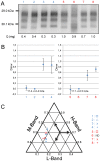Distinct transmissibility features of TSE sources derived from ruminant prion diseases by the oral route in a transgenic mouse model (TgOvPrP4) overexpressing the ovine prion protein
- PMID: 24797075
- PMCID: PMC4010433
- DOI: 10.1371/journal.pone.0096215
Distinct transmissibility features of TSE sources derived from ruminant prion diseases by the oral route in a transgenic mouse model (TgOvPrP4) overexpressing the ovine prion protein
Abstract
Transmissible spongiform encephalopathies (TSEs) are a group of fatal neurodegenerative diseases associated with a misfolded form of host-encoded prion protein (PrP). Some of them, such as classical bovine spongiform encephalopathy in cattle (BSE), transmissible mink encephalopathy (TME), kuru and variant Creutzfeldt-Jakob disease in humans, are acquired by the oral route exposure to infected tissues. We investigated the possible transmission by the oral route of a panel of strains derived from ruminant prion diseases in a transgenic mouse model (TgOvPrP4) overexpressing the ovine prion protein (A136R154Q171) under the control of the neuron-specific enolase promoter. Sources derived from Nor98, CH1641 or 87V scrapie sources, as well as sources derived from L-type BSE or cattle-passaged TME, failed to transmit by the oral route, whereas those derived from classical BSE and classical scrapie were successfully transmitted. Apart from a possible effect of passage history of the TSE agent in the inocula, this implied the occurrence of subtle molecular changes in the protease-resistant prion protein (PrPres) following oral transmission that can raises concerns about our ability to correctly identify sheep that might be orally infected by the BSE agent in the field. Our results provide proof of principle that transgenic mouse models can be used to examine the transmissibility of TSE agents by the oral route, providing novel insights regarding the pathogenesis of prion diseases.
Conflict of interest statement
Figures




Similar articles
-
Prions of ruminants show distinct splenotropisms in an ovine transgenic mouse model.PLoS One. 2010 Apr 26;5(4):e10310. doi: 10.1371/journal.pone.0010310. PLoS One. 2010. PMID: 20436680 Free PMC article.
-
Transmissibility of atypical scrapie in ovine transgenic mice: major effects of host prion protein expression and donor prion genotype.PLoS One. 2009 Oct 6;4(10):e7300. doi: 10.1371/journal.pone.0007300. PLoS One. 2009. PMID: 19806224 Free PMC article.
-
Bovine adapted transmissible mink encephalopathy is similar to L-BSE after passage through sheep with the VRQ/VRQ genotype but not VRQ/ARQ.BMC Vet Res. 2020 Oct 8;16(1):383. doi: 10.1186/s12917-020-02611-0. BMC Vet Res. 2020. PMID: 33032590 Free PMC article.
-
The transmissible spongiform encephalopathies of livestock.ILAR J. 2015;56(1):7-25. doi: 10.1093/ilar/ilv008. ILAR J. 2015. PMID: 25991695 Review.
-
Experimental interspecies transmission studies of the transmissible spongiform encephalopathies to cattle: comparison to bovine spongiform encephalopathy in cattle.J Vet Diagn Invest. 2011 May;23(3):407-20. doi: 10.1177/1040638711403404. J Vet Diagn Invest. 2011. PMID: 21908269 Review.
Cited by
-
Evolutionary biology and the risk of scrapie disease in sheep.Open Vet J. 2018;8(3):282-294. doi: 10.4314/ovj.v8i3.7. Epub 2018 Aug 7. Open Vet J. 2018. PMID: 30148080 Free PMC article. Review.
-
Interspecies transmission to bovinized transgenic mice uncovers new features of a CH1641-like scrapie isolate.Vet Res. 2018 Nov 28;49(1):116. doi: 10.1186/s13567-018-0611-1. Vet Res. 2018. PMID: 30486902 Free PMC article.
-
Bovine Spongiform Encephalopathy - A Review from the Perspective of Food Safety.Food Saf (Tokyo). 2019 Jun 13;7(2):21-47. doi: 10.14252/foodsafetyfscj.2018009. eCollection 2019 Jun. Food Saf (Tokyo). 2019. PMID: 31998585 Free PMC article. Review.
References
-
- Prusiner SB, Groth DF, Bolton DC, Kent SB, Hood LE (1984) Purification and structural studies of a major scrapie prion protein. Cell 38: 127–134. - PubMed
-
- Hoinville LJ (1996) A review of the epidemiology of scrapie in sheep. Rev Sci Tech 15: 827–852. - PubMed
-
- Miller MW, Williams ES (2003) Prion disease: horizontal prion transmission in mule deer. Nature 425: 35–36. - PubMed
-
- Wilesmith JW, Ryan JB, Atkinson MJ (1991) Bovine spongiform encephalopathy: epidemiological studies on the origin. Vet Rec 128: 199–203. - PubMed
-
- Burger D, Hartsough GR (1965) Encephalopathy of mink. II. Experimental and natural transmission. J Infect Dis 115: 393–399. - PubMed
MeSH terms
Substances
LinkOut - more resources
Full Text Sources
Other Literature Sources
Molecular Biology Databases
Research Materials

